Japan’s Hidden Jobless Hits 4.69mn, Worse Than After Lehman Shock
November 16 (Nikkei) —The number of Japanese that want to work but are not actively seeking employment has surpassed levels from after the global financial crisis erupted, according to government data released on Tuesday.
Some people have given up searching for work because they believe that the jobs they desire are not available. Known as hidden unemployment, such individuals are not reflected in official unemployment statistics, which cover those actively hunting for jobs by going to employment centers, for example.
The hidden jobless in Japan jumped by 190,000 from a year earlier to 4.69 million in the July-September quarter, excluding the three prefectures hit hardest by the March 11 disaster, the Internal Affairs Ministry said.
The figure is nearly 70% larger than the number of officially unemployed people. It is also higher than the 4.61 million in the July-September quarter of 2009, when the employment market deteriorated sharply after the financial crisis.
Of the hidden jobless, the number of women grew by 60,000 while men surged by 130,000. Asked why they are not seeking work, more people replied that there are no jobs that match their skills or their desired conditions such as pay and work hours. The strong yen and concerns over power shortages are seen as factors resulting in a dearth of openings for good jobs.
The number of unemployed people fell 430,000 on the year to 2.77 million for the July-September quarter, excluding the three disaster-hit prefectures. Of this figure, those that have been out of work for at least a year declined by 190,000 to 1.03 million, down for the second straight quarter. While this suggests that fewer people are without work over the long term, some may have exited the employment market by giving up on the job search.
Tag Archives: Unemployment
Merkel comments
*DJ Merkel: “Euro Zone Solidarity Must Be Combined With Sound Budget Measures”
To make sure unemployment never comes down and unit labor costs stay down.
*DJ Merkel: Italy Will Put Through Planned Austerity Measures Soon
Also to make sure unemployment never comes down and unit labor costs stay down.
Payrolls and a Fed rant
Utter failure of policy.
The Fed was certain it knew what Japan had done wrong and wasn’t going to make THOSE mistakes.
So it
Cut rates much more aggressively.
Said it would do whatever it takes.
Figured out how to do its job as liquidity provider after only 6 months of alphabet soup programs.
Did heaps of Quantitative Easing.
Did the twist.
And now, realizing its done about all it can do, says monetary policy can’t do it all.
And still fails to recognize publicly the actual problem is the budget deficit is way too small.
And doesn’t directly inform Congress that
there is no such thing as a solvency problem,
the Fed controls government interest rates, and not the market,
there is no long term deficit problem with regards to finance,
the only thing we owe China is a bank statement,
Quantitative Easing and rate cuts remove interest income from the economy, which allows the deficit to be that much larger,
etc.
as we continue to go the way of Japan.
Karim writes:
Some improvement around the edges but the larger narrative is employment rising only at a rate fast enough to keep the unemployment rate stable (not higher or lower)
- NFP 80k with net revisions 102k
- Unemp rate down to 9% from 9.1%
- Average hourly earnings 0.2% and aggregate hours 0.1% barely ok for labor income once adjusted for inflation
- Weather may have played a small role as construction employment turned from +27k to -20k
- Diffusion index improved from 56.7 to 60.7; while encouraging in that the majority of industries are adding jobs, doesn’t say or mean they are necessarily adding jobs at an increasing rate
- Other positives are median duration of unemployment falling from 22.2 weeks to 20.8 weeks and U6 measure falling from 16.5% to 16.2%
- Don’t think this would have a big impact on the new Fed forecasts we saw the other day
Jobless Claims Dip, Still in Range; Trade Deficit Jumps
As previously discussed, the real economy seems to be muddling through, and at firmer levels than the first half of the year.
The trade report will probably result in Q2 GDP being revised down to just below 1%, but up from the .4% reported for Q1
So Q3 still looks like it will be at least as strong as q2 and likely higher with lower gasoline prices and Japan coming back some.
With corporate profits still looking reasonably strong, corporations continue to demonstrate they can do reasonably well even with low GDP growth and high unemployment.
And with a federal deficit of around 9% of GDP continually adding income, sales, and savings I don’t see a lot of downside to GDP, sales, and profits, though a small negative print is certainly possible.
Jobless Claims Dip, Still in Range; Trade Deficit Jumps
August 11 (Reuters) — New U.S. claims for unemployment benefits dropped to a four-month low last week, government data showed on Thursday, a rare dose of good news for an economy that has been battered by a credit rating downgrade and falling share prices.
Initial claims for state unemployment benefits fell 7,000 to a seasonally adjusted 395,000, the Labor Department said, the lowest level since the week ended April 2.
Economists polled by Reuters had forecast claims steady at 400,000. The prior week’s figure was revised up to 402,000 from the previously reported 400,000.
The Federal Reserve said on Tuesday economic growth was considerably weaker than expected and unemployment would fall only gradually. The U.S. central bank promised to keep interest rates near zero until at least mid-2013.
Hiring accelerated in July after abruptly slowing in the past two months. However, there are worries that a sharp sell-off in stocks and a nasty fight between Democrats and Republicans over raising the government’s debt ceiling could dampen employers’ enthusiasm to hire new workers.
The continued improvement in the labor market could help to allay fears of a new recession, which have been stoked by the economy’s anemic growth pace in the first half of the year.
A Labor Department official said there was nothing unusual in the state-level claims data, adding that only one state had been estimated.
The four-week moving average of claims, considered a better measure of labor market trends, slipped 3,250 to 405,000. Economists say both initial claims and the four-week average need to drop close to 350,000 to signal a sustainable improvement in the labor market.
The number of people still receiving benefits under regular state programs after an initial week of aid dropped 60,000 to 3.69 million in the week ended July 30.
The number of Americans on emergency unemployment benefits fell 26,309 to 3.16 million in the week ended July 23, the latest week for which data is available.
A total of 7.48 million people were claiming unemployment benefits during that period under all programs, down 89,945 from the prior week.
Trade Gap Grows
The US. trade gap widened in June to its largest since October 2008, as both U.S. imports and exports declined in a sign of slowing global demand, a government report showed on Thursday.
The June trade deficit leapt to $53.1 billion, surprising analysts who expected it to narrow to $48 billion from an upwardly revised estimate of $50.8 billion in May.
Overall U.S. imports fell by close to 1 percent, despite a rise in value of crude oil imports to the highest since August 2008. Higher volume pushed the oil import bill higher, as the average price for imported oil fell to $106 per barrel after rising in each of the eight prior months.
U.S. exports fell for a second consecutive month to $170.9 billion, as shipments to Canada, Mexico, Brazil, Central America, France, China and Japan all declined.
Economy Faces a Jolt as Benefit Checks Run Out
When there is a lack of aggregate demand due to high ‘savings desires’ as the unemployed take jobs when benefits expire, it just means someone else loses a job, and then some, as govt deficit spending falls as well, further reducing aggregate demand. It also serves to drive down wages, as per the latest jobs report.
Economy Faces a Jolt as Benefit Checks Run Out
By Motoko Rich
July 11 (NYT) — An extraordinary amount of personal income is coming directly from the government.
Close to $2 of every $10 that went into Americans’ wallets last year were payments like jobless benefits, food stamps, Social Security and disability, according to an analysis by Moody’s Analytics. In states hit hard by the downturn, like Arizona, Florida, Michigan and Ohio, residents derived even more of their income from the government.
By the end of this year, however, many of those dollars are going to disappear, with the expiration of extended benefits intended to help people cope with the lingering effects of the recession. Moody’s Analytics estimates $37 billion will be drained from the nation’s pocketbooks this year.
In terms of economic impact, that is slightly less than the spending cuts Congress enacted to keep the government financed through September, averting a shutdown.
Unless hiring picks up sharply to compensate, economists fear that the lost income will further crimp consumer spending and act as a drag on a recovery that is still quite fragile. Among the other supports that are slipping away are federal aid to the states, the Federal Reserve’s program to pump money into the economy and the payroll tax cut, scheduled to expire at the end of the year.
“If we don’t get more job growth and gains in wages and salaries, then consumers just aren’t going to have the firepower to spend, and the economy is going to weaken,” said Mark Zandi, chief economist of Moody’s Analytics, a macroeconomic consulting firm.
Job growth has remained elusive. There are 4.6 unemployed workers for every opening, according to the Labor Department, and Friday’s unemployment report showed that employers added an anemic 18,000 jobs in June.
In Arizona, where there are 10 job seekers for every opening, 45,000 people could lose benefits by the end of the year, according to estimates from the state Department of Economic Security. Yet employers in the state have added just 4,000 jobs over the last 12 months.
Some other states will also feel a disproportionate loss of income unless hiring revives. In Florida, where nearly 476,000 people are collecting unemployment benefits, employers have added only 11,200 jobs in the last year. In Michigan, employers have added about 40,000 jobs since May 2010, but about 267,000 people are claiming jobless benefits.
Throughout the recession and its aftermath, government benefits have helped keep money in people’s wallets and, in turn, circulating among businesses. Total government payments rose to $2.3 trillion in 2010, from $1.7 trillion in 2007, an increase of about 35 percent.
While some of that growth was in Social Security and disability benefits as the population aged, the majority resulted from payments to people continuing to suffer from the recession, said Mr. Zandi. Unemployment benefits, including emergency and extended benefits, are more than three times their prerecession level, he said. The nearly 20 percent of personal income now provided by the government is close to a record high.
Approved by Congress last December, the final extension of jobless benefits — for a maximum of 99 weeks for each unemployed person — is scheduled to conclude at the end of this year. A handful of states, like Wisconsin and Arizona, have already cut off weeks 80 through 99 for their residents. Meanwhile, more of the long-term unemployed are bumping up against the 99-week limit.
Consumers account for an estimated 60 to 70 percent of the country’s economic activity, but two years into the official recovery, businesses are still complaining that people simply are not spending enough.
“Regardless of why people have less money to spend, it affects all retailers in all industries,” said Michael Siemienas, spokesman for SuperValu, which operates grocery chains including Cub Foods, Shop ’n Save and Save-A-Lot. Mr. Siemienas said that the number of SuperValu’s customers using electronic benefit transfers to pay bills had grown over the last year.
Because benefit payments tend to be spent right away to cover basic needs like food and rent, they provide a direct boost to consumer spending. In a study for the Labor Department, Wayne Vroman, an economist at the Urban Institute, estimated that every $1 paid in jobless benefits generated as much as $2 in the economy.
For many of the nearly 7.5 million people collecting unemployment benefits, those payments are keeping them afloat. Laura Metz, 42, was laid off from a clerical job paying $15.30 an hour at a home health care provider near her home in Commerce, Mich., nearly 15 months ago. She has been collecting $362 a week in unemployment insurance and about $50 a month in food stamps.
That covers the basics. But Ms. Metz stopped making her mortgage payments last year on the modest home she shares with her 19-year-old son. A program that allowed her to make a lower monthly payment has expired, and she is waiting to see if the lender will modify her loan. She can no longer make her student loan payments for her bachelor’s degree or master’s in business administration, and she has downgraded her Internet and cable service and cut back on car trips and snacks.
Ms. Metz, who has been applying for administrative jobs, has been shocked at the dearth of opportunities. A decade ago, when she applied for clerical jobs, “as soon as I walked up, there was a sign saying ‘We’re hiring,’ but it’s not like that now,” she said. “It’s really, really difficult.”
Businesses that rely heavily on low-income shoppers worry that their customers will have little to spend. Najib Atisha, who co-owns two small grocery stores in Detroit, said people receiving government assistance made up about a third of his customers downtown and as much as 60 percent at his store on the west side of the city.
“Of course, we’re hoping that things will turn around, but it’s always easier to lose jobs than it is to gain jobs,” Mr. Atisha said. “I think it’s going to take twice as long to rebound as it took to get where we are now.”
Some business groups argue that extending unemployment benefits has had deleterious effects on employers and potential workers.
“It’s having a chilling effect on hiring,” said Wendy Block, director of health policy and human resources at the Michigan Chamber of Commerce. “At one point, our unemployment taxes were just a blip on the balance sheet, but when you’re talking over $500 a head, this is significant.” Last year, Michigan spent $6.2 billion on jobless benefits, according to the National Employment Law Center.
Some economic studies show that people who collect unemployment benefits are less likely to look for or accept work until their benefits are close to running out.
“Unemployment insurance extends the typical amount of time that people will spend off the job and not looking for work,” said Chris Edwards, an economist at the Cato Institute, a libertarian organization.
In Michigan, Ms. Metz said that if all else failed, she would have to move in with her parents, who live on a fixed income. But she is determined to find work before her benefits run out and plans to expand her search to include light industrial manufacturing. “It’s getting close to the end,” she said. “And I got to do what I got to do.”
Obama Responsible for Poor Jobs Picture: Bachmann
Couldn’t agree more, but for different reasons.
(feel free to repost)
Comments below:
Obama Responsible for Poor Jobs Picture: Bachmann
By Jeff Cox
July 8 (CNBC) — The dismal state of employment offers more proof that President Obama’s economic plan isn’t working, Republican presidential candidate Michele Bachmann told CNBC.
Agreed!
Speaking just after the government said unemployment rose to 9.2 percent last month, the firebrand Minnesota congresswoman and Tea Party leader delivered a blistering critique of the White House’s handling of the jobs picture, focusing specifically on the $800 billion stimulus that has failed to drive down the unemployment rate.
“The president’s own policies have clearly failed the American people,” Bachmann said. “The answer is not to double-down and continue to do more of the same. The answer is to work on what went wrong, to reverse course and have a pro-growth job agenda.”
The $800 billion did what it did- it added $800 billion in income and nominal savings to the economy- to the penny. It’s an accounting identity. If it didn’t add exactly $800 billion the accountants at the CBO would have to stay late and find their arithmetic mistake.
In fact, all entire deficit spending adds that much nominal savings to the economy. That’s where all the increased savings has come from. You could change the label of those deficit clocks to ‘world dollar savings’ and leave the numbers alone.
And note that treasury securities are functionally nothing more than savings accounts at the Fed.
Defying consensus estimates that the economy had merely hit a soft patch and was on its road to recovery, the latest jobs news instead shows just 18,000 jobs created in June and the unemployment rate when taking into consideration those not looking for work at 16.2 percent.
Right, the problem is the deficit is too small. I’ve proposed a full FICA suspension, federal revenue distributions to the state govts of $500 per capita, and an $8/hr federally funded transition job to anyone willing and able to work to facilitate the transition from unemployment to private sector employment.
Bachmann’s campaign has caught fire as polls show her in a virtual dead heat in Iowa with presumptive front-runner Mitt Romney.
In her live interview, Bachmann focused on the voices she has heard while campaigning and the angst among business owners about how Washington policies have hindered business growth.
“I have talked to business owners all across the nation,” she said. “They’re really paralyzed with fear right now. This won’t help hearing (the unemployment news) because it shows that Washington doesn’t have the solution.”
Agreed!
She spoke as Congress and the White House are locked in debate over whether to raise the $14.3 trillion debt ceiling. Bachmann dodged a question over whether the failure to increase the borrowing limit while drastically cutting spending would raise unemployment, but she said more taxes certainly aren’t the answer, either.
“We need to fundamentally restructure how government does spending,” she said. “We’re still operating under the principles of FDR and LBJ. We need to move into the 21st century so we embrace pro-growth policies. Unfortunately they’re tone deaf here in Washington, D.C. They think government is the answer, and the American people know it’s not true.”
I watched her explain how if they just do spending cuts to balance the budget that will create jobs in the long term. What she fails to understand is that with all of our ‘demand leakages’ and tighter lending standards, spending cuts have to be at least matched by tax cuts to not add to unemployment, and tax cuts have to be substantially larger than spending cuts to add to demand and reduce unemployment.
It’s a shame, because with the tea party standing for ‘taxed enough already’ the tea party candidates continue to propose balanced budgets that continue to grossly over tax us.
It’s also a shame that no one in the media has the knowledge of actual monetary operations to expose the gaping flaws in her logic. In fact, the have the same fundamental misunderstanding and tend to agree with her, including the entirely inapplicable analogy that we are in danger of becoming the next Greece.
So current odds have to favor her for the presidential nomination.
And only MMT stands between her and the presidency.
Modern Monetary Theory: The Last Progressive Left Standing
Modern Monetary Theory: The Last Progressive Left Standing
By Warren Mosler
Payrolls
Karim writes:
Not a game changer in my view and doesn’t compel the Fed to change course next week.
Private sector gradually churning out jobs; hours, wages, and diffusion index ok.
- Private payrolls up 71k after avg of 41k of prior 2mths but well off highs of 200k avg of Feb and Mar
- UE rate stays at 9.5%
- Hours up 0.3% and wages up 0.2%
- Diffusion index up to 55.6 from 55.2
- Median duration of unemployment down from 25.5 to 22.2
- U6 measure unch at 16.5%
- Job growth accelerates in manufacturing and retail; weakens in temp services and leisure/hospitality
Yes, which means it remains a good market for stocks.
High unemployment is good for cost control and helps keep the Fed on hold. And 0 rates remain a deflationary influence as well.
Top line growth is modestly positive growing by productivity increases plus some hours and employment gains.
Earnings trend remains positive with productivity gains, some top line growth, and a loose labor market.
All supported by a federal deficit that still exceeds 8% of gdp.
Tough political environment with most of the real wealth going to the top as unemployment remains near the highs.
Madness continues
>
> (email exchange)
>
> On Thu, May 27, 2010 at 6:48 PM, Marshall wrote:
>
UNEMPLOYMENT EXTENSION HUNG UP – Even after Democratic leadership scaled back its bill to reauthorize several domestic aid programs, reducing its impact on the federal budget deficit by $50 billion, conservative rank-and-file Democrats remain in their perpetual state of unhappiness. House leadership met shortly before press time to find a way forward, but all paths have major obstacles. Primarily, this one: Senate Finance Committee Chair Max Baucus tells HuffPost that he’s working out an agreement on what amendments could be offered by Republicans. But it comes at a high cost. The House had been planning to pass its bill and head out of town for the Memorial Day break. If any changes are made to the bill, it could languish over the break as programs and benefits expire. “We’re ready. Soon as the House sends it over. We will pass it,” Baucus said. “Gotta work out an agreement with the Republicans on votes. We’re going to have to work out some accommodation on amendments.”
Asked if the House would vote tonight, a brusque Steny Hoyer, leaving the leadership meeting for a floor vote, said: “We are STILL talking!” Chris Van Hollen said they were discussing possible changes with their members and could finish up before the break — but he didn’t say they’d vote tonight. Sandy Levin’s been working on Blue Dogs. Pelosi worked on Jared Polis, who’s been unhappy with the hedge fund loophole fix. The House is antsy to leave town. “Let’s go!” two separate members of Congress shouted on the floor, at least one of them a Democrat. “People are really tired,” one Dem told HuffPost. “What you’re seeing is the success of stubbornness.”
>
> CHANGE YOU CAN BELIEVE IN!!!
>
And, of course, ironically cutting the benefits only adds to unemployment as it removes demand.
Instead, they should be suspending fica taxes to restore sales and paid work.
2009-05-08 USER
Karim writes:
- NFP -539k; net revisions -66k, and +60k contribution from census workers (census workers will add about 75k jobs/mth thru year-end)
- Underlying trend doesn’t show any real change
- Index of aggregate hours down another 0.6% and avg weekly earnings up 0.1%
- Wage and salary component of personal income will be down again (hours x jobs x wages)
- Unemployment rate up from 8.54% to 8.87%; total unemployment rate up from 15.6% to 15.8%
- Only good news was diffusion index rising from 20.3 to 28.2
- Consensus on CNBC was this would be the ‘last, really bad number’, mostly on grounds of running out of people to fire.
- I guess ‘really bad’ wasn’t ‘really defined’, but judging by the workweek data, doesn’t seem like material improvement anytime soon.
- Change in Nonfarm Payrolls (Released 8:30 EST)
- Change in Nonfarm Payrolls YoY (Released 8:30 EST)
- Nonfarm Payrolls ALLX (Released 8:30 EST)
- Unemployment Rate (Released 8:30 EST)
- Unemployment Rate ALLX 1 (Released 8:30 EST)
- Unemployment Rate ALLX 2 (Released 8:30 EST)
- Change in Manufacturing Payrolls (Released 8:30 EST)
- Change in Manufacturing Payrolls YoY (Released 8:30 EST)
- Average Hourly Earnings MoM (Released 8:30 EST)
- Average Hourly Earnings YoY (Released 8:30 EST)
- Average Hourly Earnings ALLX 1 (Released 8:30 EST)
- Average Hourly Earnings ALLX 2 (Released 8:30 EST)
- Average Hourly Earnings ALLX 3 (Released 8:30 EST)
- Average Weekly Hours (Released 8:30 EST)
- Wholesale Inventories MoM (Released 10:00 EST)
- Wholesale Inventories YoY (Released 10:00 EST)
- Wholesale Inventories ALLX 1 (Released 10:00 EST)
- Wholesale Inventories ALLX 2 (Released 10:00 EST)

Change in Nonfarm Payrolls (Apr)
| Survey | -600K |
| Actual | -539K |
| Prior | -663K |
| Revised | -699K |
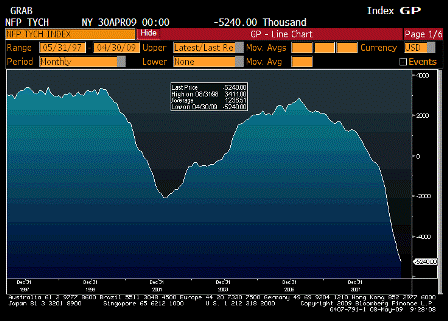
Change in Nonfarm Payrolls YoY (Apr)
| Survey | n/a |
| Actual | -5240.00 |
| Prior | -4861.00 |
| Revised | n/a |
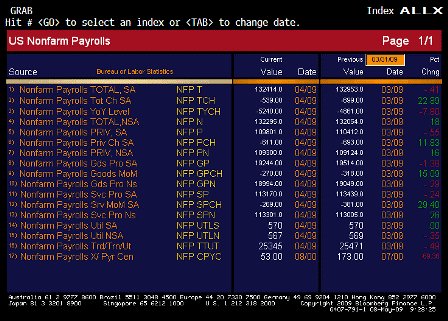
Nonfarm Payrolls ALLX (Apr)
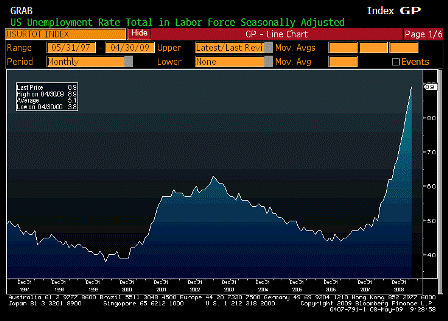
Unemployment Rate (Apr)
| Survey | 8.9% |
| Actual | 8.9% |
| Prior | 8.5% |
| Revised | n/a |
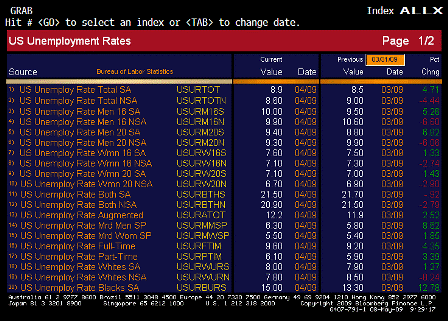
Unemployment Rate ALLX 1 (Apr)
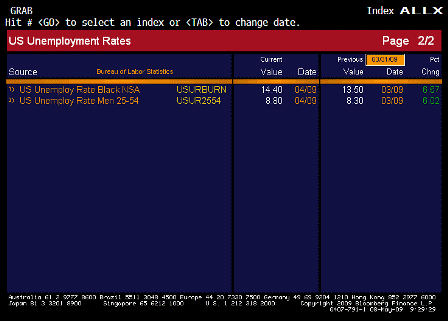
Unemployment Rate ALLX 2 (Apr)

Change in Manufacturing Payrolls (Apr)
| Survey | -155K |
| Actual | -149K |
| Prior | -161K |
| Revised | -167K |
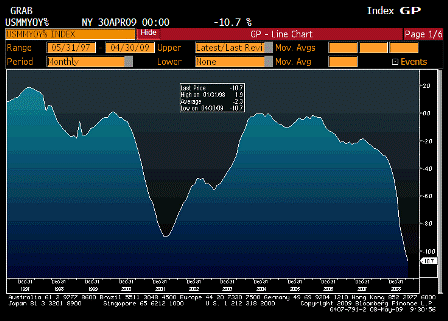
Change in Manufacturing Payrolls YoY (Apr)
| Survey | n/a |
| Actual | -10.7% |
| Prior | -10.0% |
| Revised | n/a |
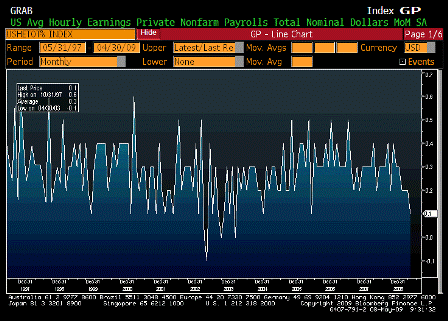
Average Hourly Earnings MoM (Apr)
| Survey | 0.2% |
| Actual | 0.1% |
| Prior | 0.2% |
| Revised | n/a |
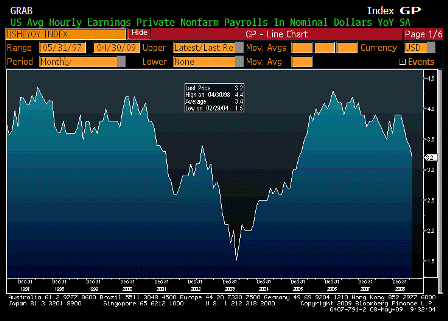
Average Hourly Earnings YoY (Apr)
| Survey | 3.3% |
| Actual | 3.2% |
| Prior | 3.4% |
| Revised | n/a |
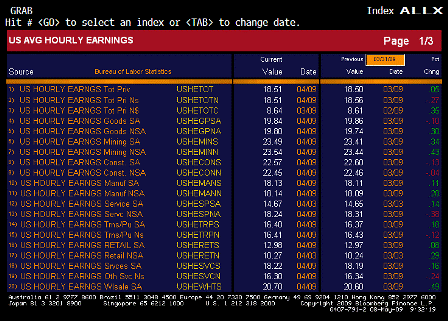
Average Hourly Earnings ALLX 1 (Apr)
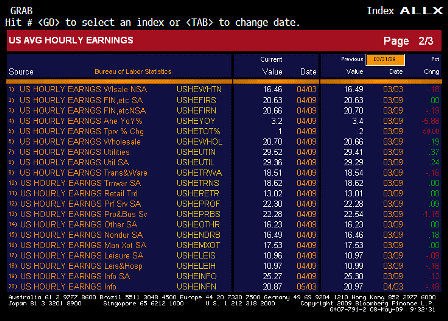
Average Hourly Earnings ALLX 2 (Apr)
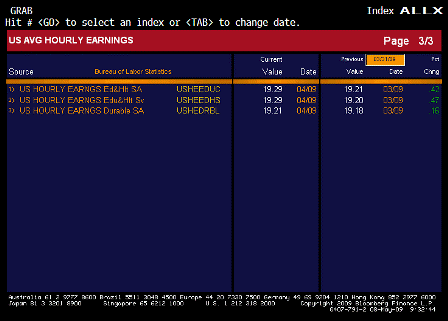
Average Hourly Earnings ALLX 3 (Apr)
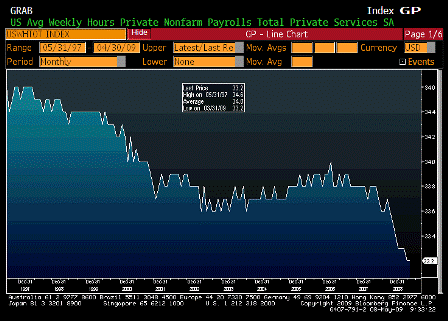
Average Weekly Hours (Apr)
| Survey | 33.2 |
| Actual | 33.2 |
| Prior | 33.2 |
| Revised | n/a |

Wholesale Inventories MoM (Mar)
| Survey | -1.0% |
| Actual | -1.6% |
| Prior | -1.5% |
| Revised | -1.7% |
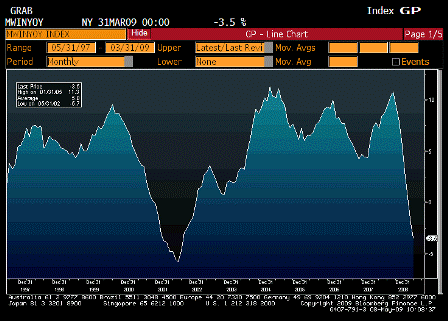
Wholesale Inventories YoY (Mar)
| Survey | n/a |
| Actual | -3.5% |
| Prior | -1.9% |
| Revised | n/a |
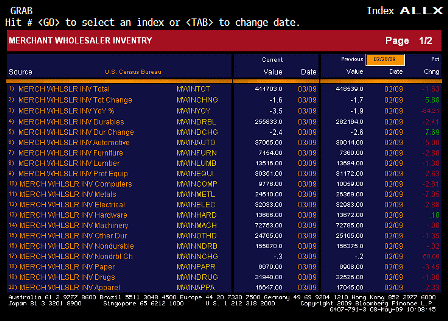
Wholesale Inventories ALLX 1 (Mar)
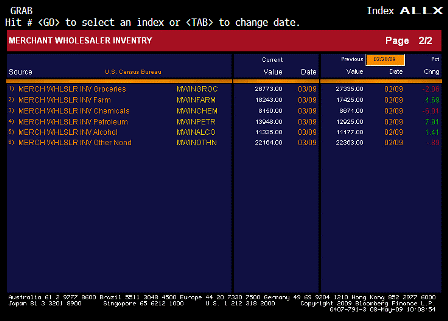
Wholesale Inventories ALLX 2 (Mar)
[top]


